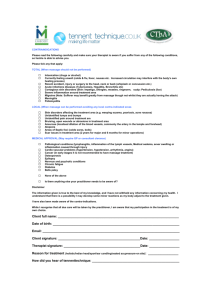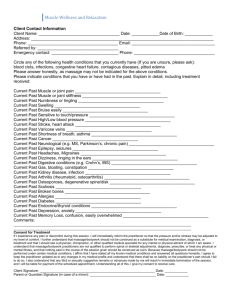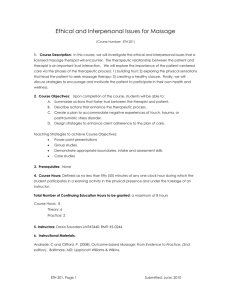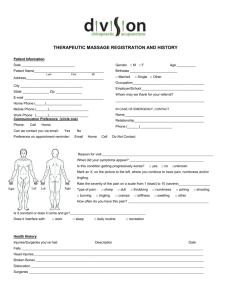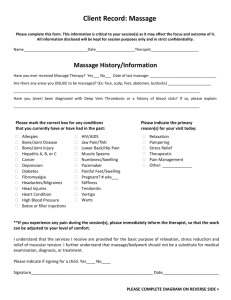Consultation and Documentation
advertisement
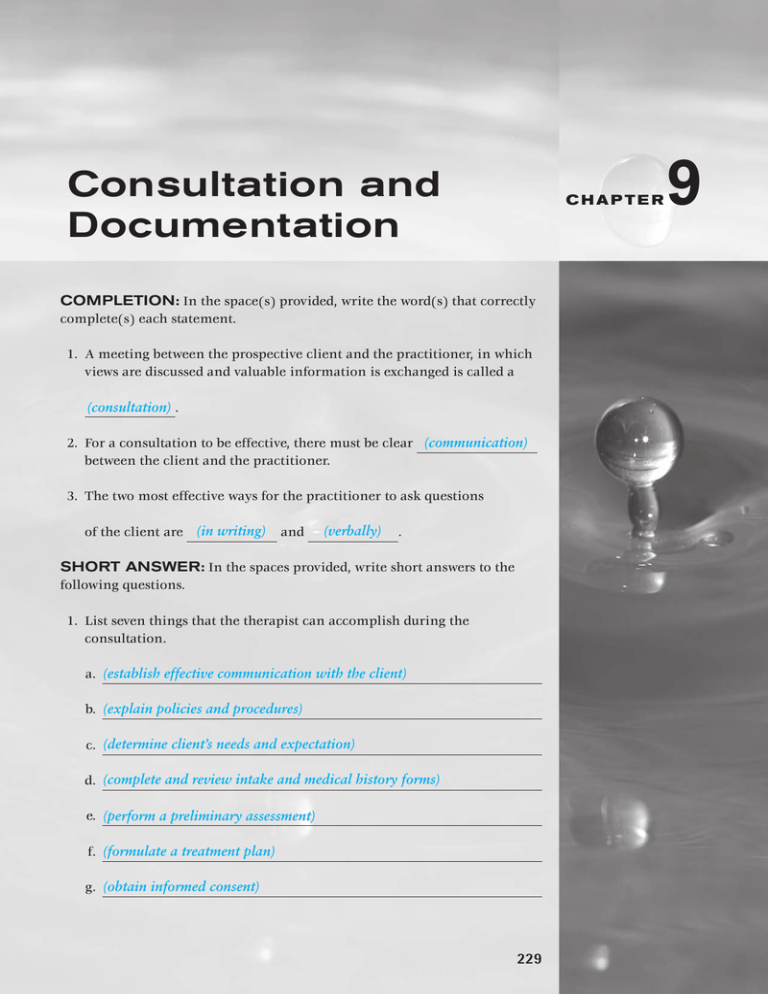
Consultation and Documentation CHAPTER COMPLETION: In the space(s) provided, write the word(s) that correctly complete(s) each statement. 1. A meeting between the prospective client and the practitioner, in which views are discussed and valuable information is exchanged is called a (consultation) . 2. For a consultation to be effective, there must be clear (communication) between the client and the practitioner. 3. The two most effective ways for the practitioner to ask questions of the client are (in writing) and (verbally) . SHORT ANSWER: In the spaces provided, write short answers to the following questions. 1. List seven things that the therapist can accomplish during the consultation. a. (establish effective communication with the client) b. (explain policies and procedures) c. (determine client’s needs and expectation) d. (complete and review intake and medical history forms) e. (perform a preliminary assessment) f. (formulate a treatment plan) g. (obtain informed consent) 229 9 Theory & Practice of Therapeutic Massage Workbook 230 2. When making a first appointment with a prospective client, what are three questions that can be asked for screening? a. (Have you had massage before?) b. (How did you find out about my services?) c. (What is your main reason for making this appointment?) 3. List four areas that a practitioner may include in a policy statement. a. (missed or late appointments) b. (payment of fees) c. (sexual boundaries) d. (services are not medical treatment) 4. List three reasons to perform a preliminary assessment. a. (determine which massage procedures to perform) b. (determine if there are contraindications for massage) c. (determine whether to refer the client to another health care professional) 5. List five topics that should be included in the massage policies and procedures. a. (type of services offered) b. (the qualifications of the therapist) c. (business policies) d. (fees) e. (session procedures) 6. List six topics that should be included as business policies. b. (cancellation policy) c. (session length) d. (confidentiality policy) e. (medical information release) f. (sexual boundary policy) Alternates: (fees, late or missed appointments) 7. List four topics of disclosure that the therapist must provide to obtain informed consent from the client. a. (the practitioner’s license and educational credentials and qualifications) b. (a description of the services offered) c. (policies and procedures) d. (a description of the proposed session, including expected outcomes and possible side effects) COMPLETION: In the space(s) provided, write the word(s) that correctly complete(s) each statement. 1. To help to disclose problems and the physiologic basis for the client’s complaints, an assessment includes (a client history) , (an observation) , and (an examination) . 2. Information gained from intake and medical history forms, answers to questions, and descriptions the client offers are the basis for the (client history) . 3. Noticing how clients hold their bodies, how they move, and how they react to questions or manipulative tests are part of (observation) . 4. Various manipulative and verbal tests that help to determine more precisely the tissues or conditions involved are part of the (examination) . 5. The outline that a practitioner develops and follows when giving massage treatments is termed a (treatment plan) . Chapter 9 Consultation and Documentation a. (the therapist’s work schedule, when he is available to take appointments) 231 Theory & Practice of Therapeutic Massage Workbook 232 SHORT ANSWER: In the spaces provided, write short answers to the following questions. 1. List four sources of information used when formulating a treatment plan. a. (the intake and medical history forms) b. (the preliminary interview and preliminary assessment) c. (records from previous sessions) d. (the client’s current needs, wants, and preferences) 2. List four types of information that are kept in the client files. a. (name, address, and phone numbers of client) b. (medical history and information) c. (treatment plans and records) d. (billing and financial information) 3. Which four types of information does a practitioner record in a treatment record? a. (which treatments were given) b. (which special products, if any, were used) c. (reactions that a client had to this or previous sessions) d. (changes in a client’s condition) 4. What are the four sections of a SOAP chart and what does each section contain? (Subjective – anything that the client tells the practitioner, including symptoms, a. expectations, and goals for the session.) (Objective – all information the practitioner gathers from observation, interviews, or b. assessments.) (Application– records what was done in the session and any progress or changes relative c. to the session.) (Plan – records plans for future sessions or homework by taking into account what was d. done in the current session.) 5. What can the practitioner do to maintain client confidentiality? (Do not divulge client information to any third party without first obtaining a form a. signed by the client that allows release of information.) b. (Store client files in a secured (lockable), fireproof cabinet.) (Protect electronic files with appropriate passwords. If the computer is connected to the c. Internet, use appropriate firewalls.) d. (Keep client files and appointment books out of view of others.) MULTIPLE CHOICE: Carefully read each statement. Choose the word or phrase that correctly completes the meaning and write the corresponding letter in the blank provided. 2. Client information can be obtained by a) consulting with a doctor b) personal history forms c) client interviews d) all of the above (b) (d) 3. A thorough preliminary client assessment includes a a) client history c) client examination b) client observation d) all the above (d) 4. Noticing how the client holds his body and how he moves is called a) body mechanics c) personology b) observation d) subjective assessment (b) 5. An outline that the practitioner can follow for giving treatments is called a a) treatment plan c) recipe b) client history d) client file (a) 6. Work performed on a client is documented in the a) treatment plan c) SOAP notes b) client history d) billing records (c) 7. Accurate records of a client’s treatment help the therapist to a) achieve better results c) compare progress with other clients b) abide by state laws d) charge higher fees (a) 8. All client information should be considered a) before calling their physician c) when diagnosing their condition b) research material d) confidential (d) 9. When should the practitioner obtain informed consent from the client? c) when there are changes in a) at the end of the consultation, the course of treatment after adequate information has been exchanged b) when a treatment plan has d) all of the above been agreed on (d) Chapter 9 Consultation and Documentation 1. The process of clarifying the appropriateness of an appointment is called a) consultation c) selecting b) screening d) discrimination 233 Theory & Practice of Therapeutic Massage Workbook 234 10. Downcast eyes, slouching shoulders, a bright smile, and fidgeting hands are all examples of a) emotional insecurity c) body language b) body mechanics d) nervousness 11. Which of the following is not part of an initial consultation? c) provide information to client a) review outcomes related to about credentials and training desired goals d) obtain informed consent b) determine client’s expectations and needs (c) (a) WORD REVIEW: The student is encouraged to write down the meaning of each of the following words. The list can be used as a study guide for this unit. body language (Body language consists of postures, gestures, and movements that can nonverbally express physical, emotional, or mental messages.) client file (The client file is documentation kept by the therapist containing information regarding the client and course of treatment.) confidentiality (Confidentiality is the practice of not sharing personal information gained during a personal or therapeutic relationship with others unless authorized to do so.) consultation (A consultation is an interview process that helps to determine the course of treatment and sets the tone of the therapeutic relationship between the client and therapist.) informed consent (Informed consent is a client’s written authorization for professional services based on adequate information from the massage therapist about the massage, including expectations, potential benefits, possible undesirable effects, and professional and ethical responsibility.) medical history (Medical history is information relating to a client’s current and former medical concerns that is used to determine the best treatment strategy.) nonverbal communication and facial expressions provide information about his mental, emotional, or physical condition.) policies and procedures (Policies and procedures are statements of business operation and client interaction practices.) preliminary assessment (Preliminary assessment is the extensive consultation preceding the first massage.) rapport (Rapport is a personal connection that is the basis for trust, mutual respect, openness, and harmony.) SOAP notes (SOAP notes are methods of documenting client and session information; the acronym stands for Subjective, Objective, Assessment, and Planning.) treatment plan (A treatment plan is an outline that the practitioner can follow when giving treatments that takes into account information from the preliminary interview and assessment to formulate session goals and strategies.) Chapter 9 Consultation and Documentation (Nonverbal communication, also known as body language, is how a person’s posturing, gestures, 235
